Logistics and Supply Chain Management: A Comprehensive Report
VerifiedAdded on 2021/04/17
|37
|11569
|290
Report
AI Summary
This report provides a comprehensive analysis of logistics and supply chain management, focusing on the retail sector. It begins with an overview of the modern business environment, highlighting challenges such as globalization, hyper-competition, and the impact of digital technologies. The report then delves into retail business operations, exploring opportunities like omnichannel systems and challenges related to data management and inventory visibility. Various retail business strategies, including remuneration, training, inventory management, and customer engagement, are discussed. The main body of the report examines globalized business operations and their influence on corporate competitiveness, along with the challenges and opportunities within retail. It explores supply chain strategies, including collaboration and integration, and discusses airport retail business strategies and areas for improvement. The report incorporates a DDF case study to demonstrate the necessity of supply chain collaboration and integration. Finally, the report concludes with a discussion of the methodology used, including research design, techniques, and limitations, providing a well-rounded view of logistics and supply chain management in the retail context.
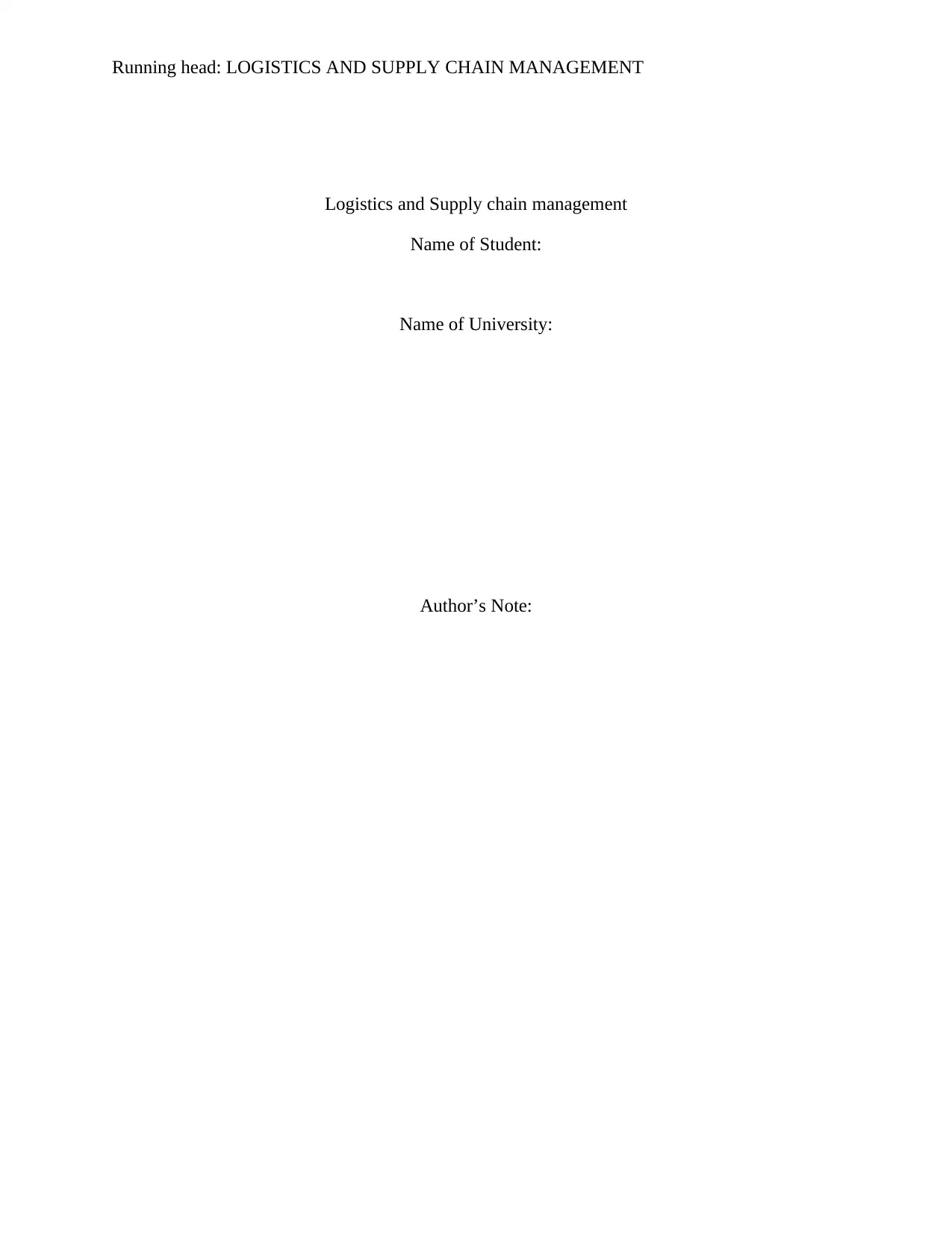
Running head: LOGISTICS AND SUPPLY CHAIN MANAGEMENT
Logistics and Supply chain management
Name of Student:
Name of University:
Author’s Note:
Logistics and Supply chain management
Name of Student:
Name of University:
Author’s Note:
Paraphrase This Document
Need a fresh take? Get an instant paraphrase of this document with our AI Paraphraser
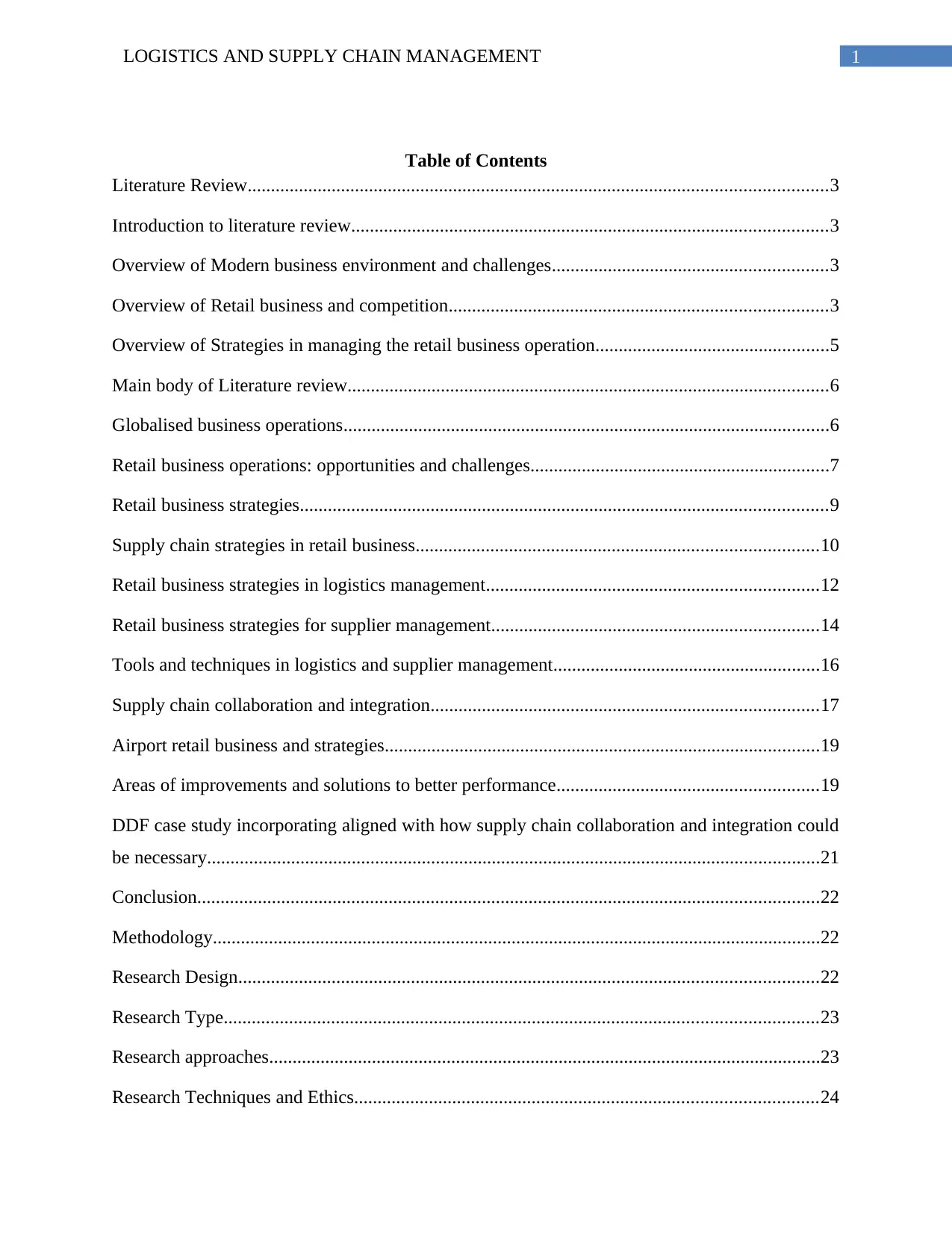
1LOGISTICS AND SUPPLY CHAIN MANAGEMENT
Table of Contents
Literature Review............................................................................................................................3
Introduction to literature review......................................................................................................3
Overview of Modern business environment and challenges...........................................................3
Overview of Retail business and competition.................................................................................3
Overview of Strategies in managing the retail business operation..................................................5
Main body of Literature review.......................................................................................................6
Globalised business operations........................................................................................................6
Retail business operations: opportunities and challenges................................................................7
Retail business strategies.................................................................................................................9
Supply chain strategies in retail business......................................................................................10
Retail business strategies in logistics management.......................................................................12
Retail business strategies for supplier management......................................................................14
Tools and techniques in logistics and supplier management.........................................................16
Supply chain collaboration and integration...................................................................................17
Airport retail business and strategies.............................................................................................19
Areas of improvements and solutions to better performance........................................................19
DDF case study incorporating aligned with how supply chain collaboration and integration could
be necessary...................................................................................................................................21
Conclusion.....................................................................................................................................22
Methodology..................................................................................................................................22
Research Design............................................................................................................................22
Research Type...............................................................................................................................23
Research approaches......................................................................................................................23
Research Techniques and Ethics...................................................................................................24
Table of Contents
Literature Review............................................................................................................................3
Introduction to literature review......................................................................................................3
Overview of Modern business environment and challenges...........................................................3
Overview of Retail business and competition.................................................................................3
Overview of Strategies in managing the retail business operation..................................................5
Main body of Literature review.......................................................................................................6
Globalised business operations........................................................................................................6
Retail business operations: opportunities and challenges................................................................7
Retail business strategies.................................................................................................................9
Supply chain strategies in retail business......................................................................................10
Retail business strategies in logistics management.......................................................................12
Retail business strategies for supplier management......................................................................14
Tools and techniques in logistics and supplier management.........................................................16
Supply chain collaboration and integration...................................................................................17
Airport retail business and strategies.............................................................................................19
Areas of improvements and solutions to better performance........................................................19
DDF case study incorporating aligned with how supply chain collaboration and integration could
be necessary...................................................................................................................................21
Conclusion.....................................................................................................................................22
Methodology..................................................................................................................................22
Research Design............................................................................................................................22
Research Type...............................................................................................................................23
Research approaches......................................................................................................................23
Research Techniques and Ethics...................................................................................................24
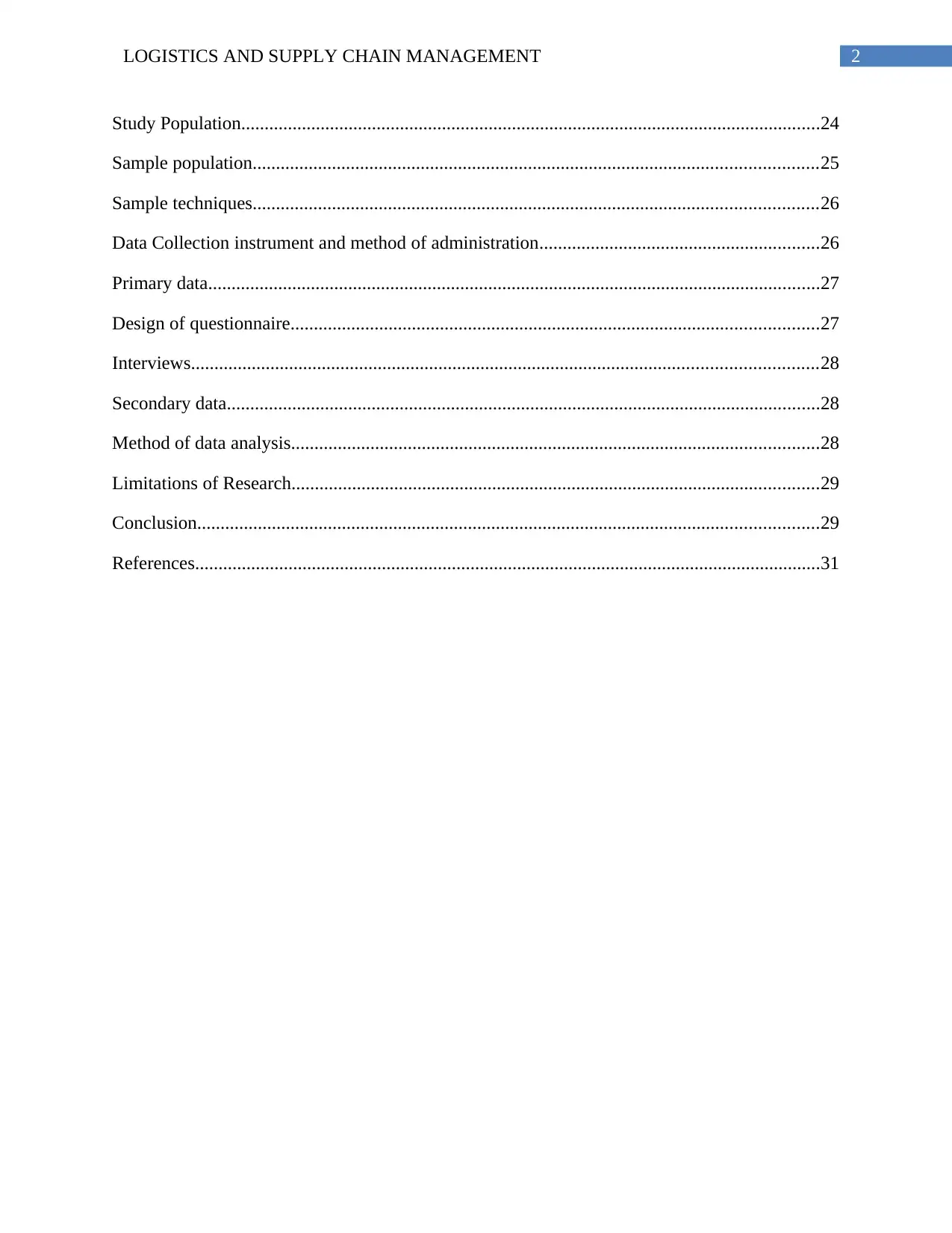
2LOGISTICS AND SUPPLY CHAIN MANAGEMENT
Study Population............................................................................................................................24
Sample population.........................................................................................................................25
Sample techniques.........................................................................................................................26
Data Collection instrument and method of administration............................................................26
Primary data...................................................................................................................................27
Design of questionnaire.................................................................................................................27
Interviews......................................................................................................................................28
Secondary data...............................................................................................................................28
Method of data analysis.................................................................................................................28
Limitations of Research.................................................................................................................29
Conclusion.....................................................................................................................................29
References......................................................................................................................................31
Study Population............................................................................................................................24
Sample population.........................................................................................................................25
Sample techniques.........................................................................................................................26
Data Collection instrument and method of administration............................................................26
Primary data...................................................................................................................................27
Design of questionnaire.................................................................................................................27
Interviews......................................................................................................................................28
Secondary data...............................................................................................................................28
Method of data analysis.................................................................................................................28
Limitations of Research.................................................................................................................29
Conclusion.....................................................................................................................................29
References......................................................................................................................................31
⊘ This is a preview!⊘
Do you want full access?
Subscribe today to unlock all pages.

Trusted by 1+ million students worldwide
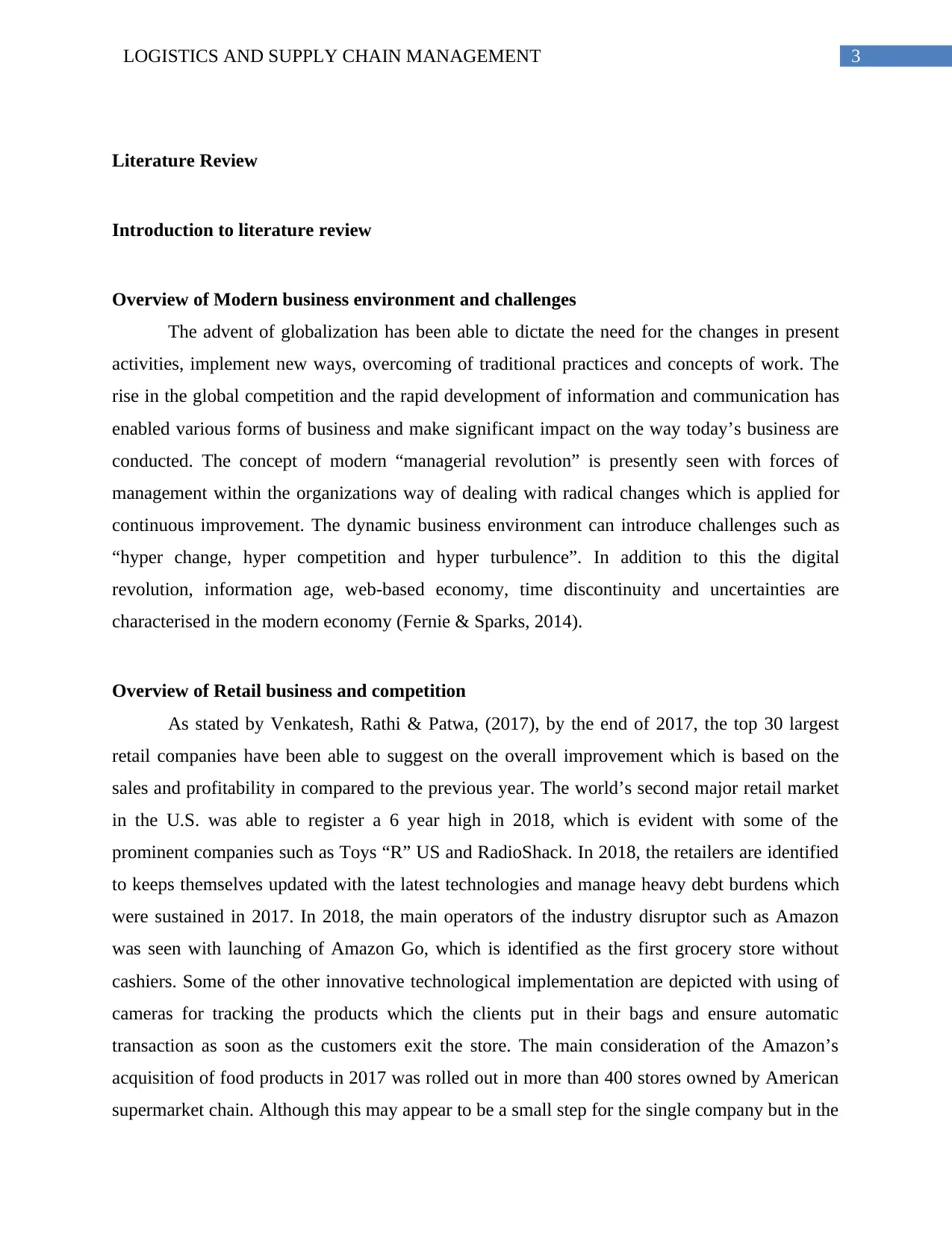
3LOGISTICS AND SUPPLY CHAIN MANAGEMENT
Literature Review
Introduction to literature review
Overview of Modern business environment and challenges
The advent of globalization has been able to dictate the need for the changes in present
activities, implement new ways, overcoming of traditional practices and concepts of work. The
rise in the global competition and the rapid development of information and communication has
enabled various forms of business and make significant impact on the way today’s business are
conducted. The concept of modern “managerial revolution” is presently seen with forces of
management within the organizations way of dealing with radical changes which is applied for
continuous improvement. The dynamic business environment can introduce challenges such as
“hyper change, hyper competition and hyper turbulence”. In addition to this the digital
revolution, information age, web-based economy, time discontinuity and uncertainties are
characterised in the modern economy (Fernie & Sparks, 2014).
Overview of Retail business and competition
As stated by Venkatesh, Rathi & Patwa, (2017), by the end of 2017, the top 30 largest
retail companies have been able to suggest on the overall improvement which is based on the
sales and profitability in compared to the previous year. The world’s second major retail market
in the U.S. was able to register a 6 year high in 2018, which is evident with some of the
prominent companies such as Toys “R” US and RadioShack. In 2018, the retailers are identified
to keeps themselves updated with the latest technologies and manage heavy debt burdens which
were sustained in 2017. In 2018, the main operators of the industry disruptor such as Amazon
was seen with launching of Amazon Go, which is identified as the first grocery store without
cashiers. Some of the other innovative technological implementation are depicted with using of
cameras for tracking the products which the clients put in their bags and ensure automatic
transaction as soon as the customers exit the store. The main consideration of the Amazon’s
acquisition of food products in 2017 was rolled out in more than 400 stores owned by American
supermarket chain. Although this may appear to be a small step for the single company but in the
Literature Review
Introduction to literature review
Overview of Modern business environment and challenges
The advent of globalization has been able to dictate the need for the changes in present
activities, implement new ways, overcoming of traditional practices and concepts of work. The
rise in the global competition and the rapid development of information and communication has
enabled various forms of business and make significant impact on the way today’s business are
conducted. The concept of modern “managerial revolution” is presently seen with forces of
management within the organizations way of dealing with radical changes which is applied for
continuous improvement. The dynamic business environment can introduce challenges such as
“hyper change, hyper competition and hyper turbulence”. In addition to this the digital
revolution, information age, web-based economy, time discontinuity and uncertainties are
characterised in the modern economy (Fernie & Sparks, 2014).
Overview of Retail business and competition
As stated by Venkatesh, Rathi & Patwa, (2017), by the end of 2017, the top 30 largest
retail companies have been able to suggest on the overall improvement which is based on the
sales and profitability in compared to the previous year. The world’s second major retail market
in the U.S. was able to register a 6 year high in 2018, which is evident with some of the
prominent companies such as Toys “R” US and RadioShack. In 2018, the retailers are identified
to keeps themselves updated with the latest technologies and manage heavy debt burdens which
were sustained in 2017. In 2018, the main operators of the industry disruptor such as Amazon
was seen with launching of Amazon Go, which is identified as the first grocery store without
cashiers. Some of the other innovative technological implementation are depicted with using of
cameras for tracking the products which the clients put in their bags and ensure automatic
transaction as soon as the customers exit the store. The main consideration of the Amazon’s
acquisition of food products in 2017 was rolled out in more than 400 stores owned by American
supermarket chain. Although this may appear to be a small step for the single company but in the
Paraphrase This Document
Need a fresh take? Get an instant paraphrase of this document with our AI Paraphraser
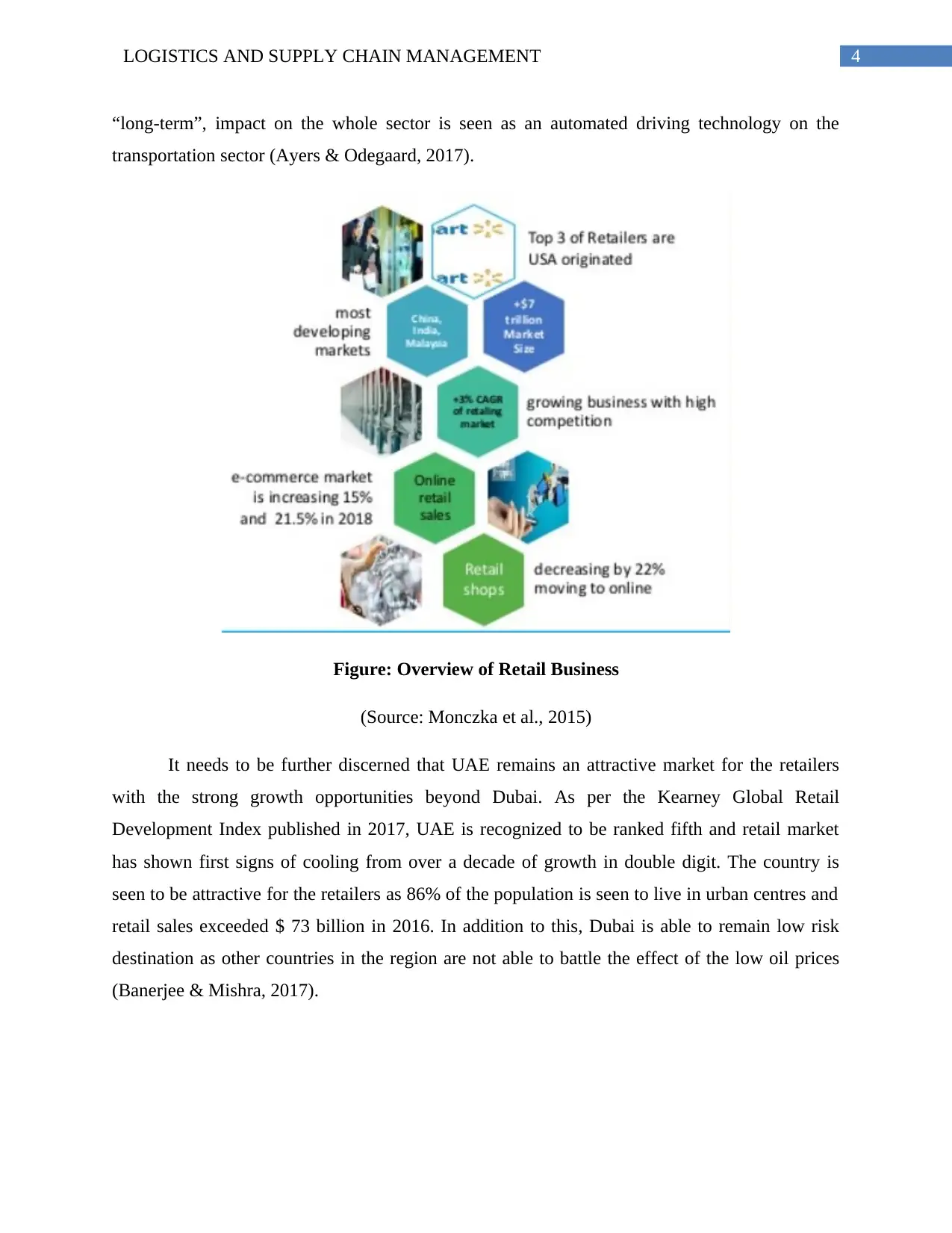
4LOGISTICS AND SUPPLY CHAIN MANAGEMENT
“long-term”, impact on the whole sector is seen as an automated driving technology on the
transportation sector (Ayers & Odegaard, 2017).
Figure: Overview of Retail Business
(Source: Monczka et al., 2015)
It needs to be further discerned that UAE remains an attractive market for the retailers
with the strong growth opportunities beyond Dubai. As per the Kearney Global Retail
Development Index published in 2017, UAE is recognized to be ranked fifth and retail market
has shown first signs of cooling from over a decade of growth in double digit. The country is
seen to be attractive for the retailers as 86% of the population is seen to live in urban centres and
retail sales exceeded $ 73 billion in 2016. In addition to this, Dubai is able to remain low risk
destination as other countries in the region are not able to battle the effect of the low oil prices
(Banerjee & Mishra, 2017).
“long-term”, impact on the whole sector is seen as an automated driving technology on the
transportation sector (Ayers & Odegaard, 2017).
Figure: Overview of Retail Business
(Source: Monczka et al., 2015)
It needs to be further discerned that UAE remains an attractive market for the retailers
with the strong growth opportunities beyond Dubai. As per the Kearney Global Retail
Development Index published in 2017, UAE is recognized to be ranked fifth and retail market
has shown first signs of cooling from over a decade of growth in double digit. The country is
seen to be attractive for the retailers as 86% of the population is seen to live in urban centres and
retail sales exceeded $ 73 billion in 2016. In addition to this, Dubai is able to remain low risk
destination as other countries in the region are not able to battle the effect of the low oil prices
(Banerjee & Mishra, 2017).
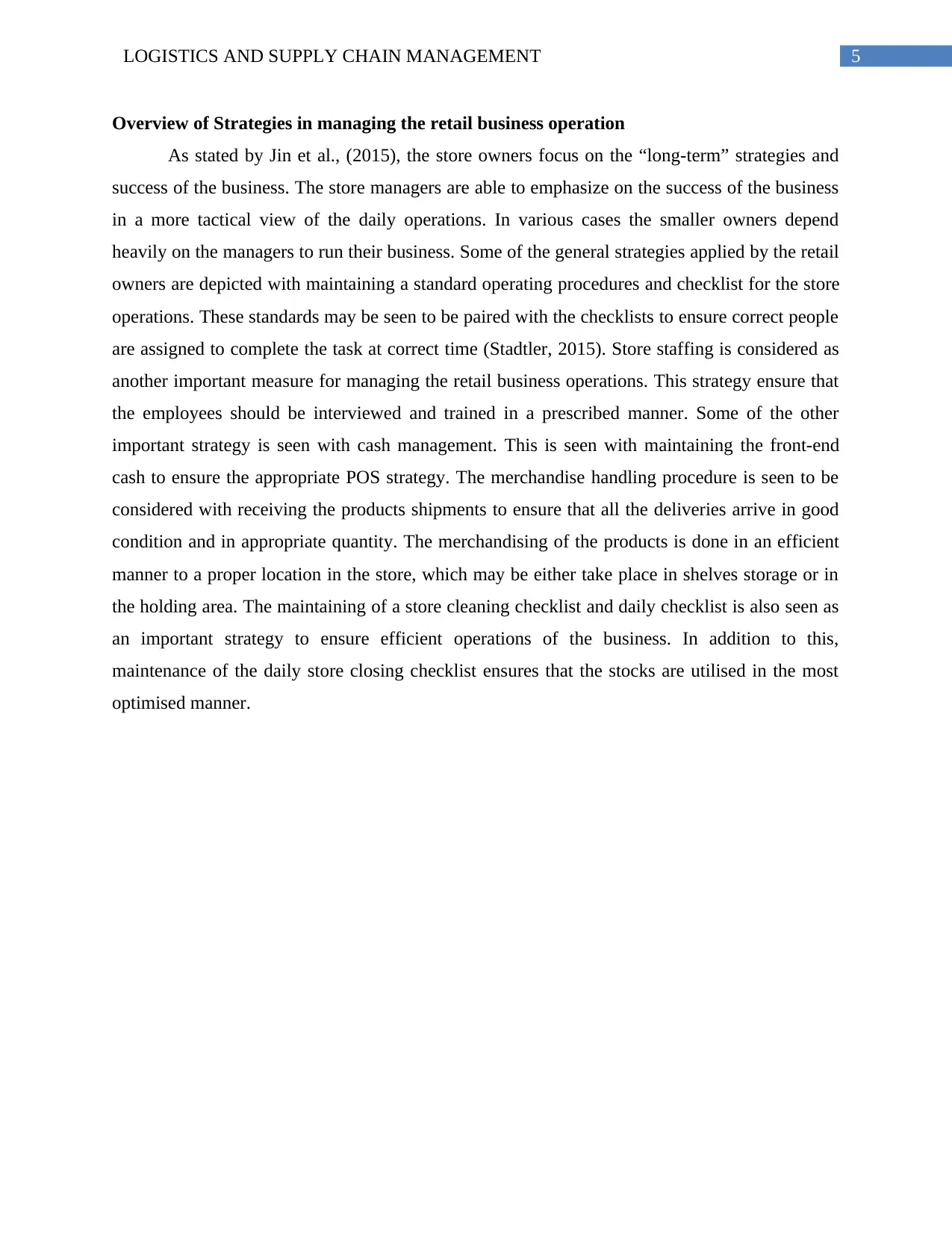
5LOGISTICS AND SUPPLY CHAIN MANAGEMENT
Overview of Strategies in managing the retail business operation
As stated by Jin et al., (2015), the store owners focus on the “long-term” strategies and
success of the business. The store managers are able to emphasize on the success of the business
in a more tactical view of the daily operations. In various cases the smaller owners depend
heavily on the managers to run their business. Some of the general strategies applied by the retail
owners are depicted with maintaining a standard operating procedures and checklist for the store
operations. These standards may be seen to be paired with the checklists to ensure correct people
are assigned to complete the task at correct time (Stadtler, 2015). Store staffing is considered as
another important measure for managing the retail business operations. This strategy ensure that
the employees should be interviewed and trained in a prescribed manner. Some of the other
important strategy is seen with cash management. This is seen with maintaining the front-end
cash to ensure the appropriate POS strategy. The merchandise handling procedure is seen to be
considered with receiving the products shipments to ensure that all the deliveries arrive in good
condition and in appropriate quantity. The merchandising of the products is done in an efficient
manner to a proper location in the store, which may be either take place in shelves storage or in
the holding area. The maintaining of a store cleaning checklist and daily checklist is also seen as
an important strategy to ensure efficient operations of the business. In addition to this,
maintenance of the daily store closing checklist ensures that the stocks are utilised in the most
optimised manner.
Overview of Strategies in managing the retail business operation
As stated by Jin et al., (2015), the store owners focus on the “long-term” strategies and
success of the business. The store managers are able to emphasize on the success of the business
in a more tactical view of the daily operations. In various cases the smaller owners depend
heavily on the managers to run their business. Some of the general strategies applied by the retail
owners are depicted with maintaining a standard operating procedures and checklist for the store
operations. These standards may be seen to be paired with the checklists to ensure correct people
are assigned to complete the task at correct time (Stadtler, 2015). Store staffing is considered as
another important measure for managing the retail business operations. This strategy ensure that
the employees should be interviewed and trained in a prescribed manner. Some of the other
important strategy is seen with cash management. This is seen with maintaining the front-end
cash to ensure the appropriate POS strategy. The merchandise handling procedure is seen to be
considered with receiving the products shipments to ensure that all the deliveries arrive in good
condition and in appropriate quantity. The merchandising of the products is done in an efficient
manner to a proper location in the store, which may be either take place in shelves storage or in
the holding area. The maintaining of a store cleaning checklist and daily checklist is also seen as
an important strategy to ensure efficient operations of the business. In addition to this,
maintenance of the daily store closing checklist ensures that the stocks are utilised in the most
optimised manner.
⊘ This is a preview!⊘
Do you want full access?
Subscribe today to unlock all pages.

Trusted by 1+ million students worldwide
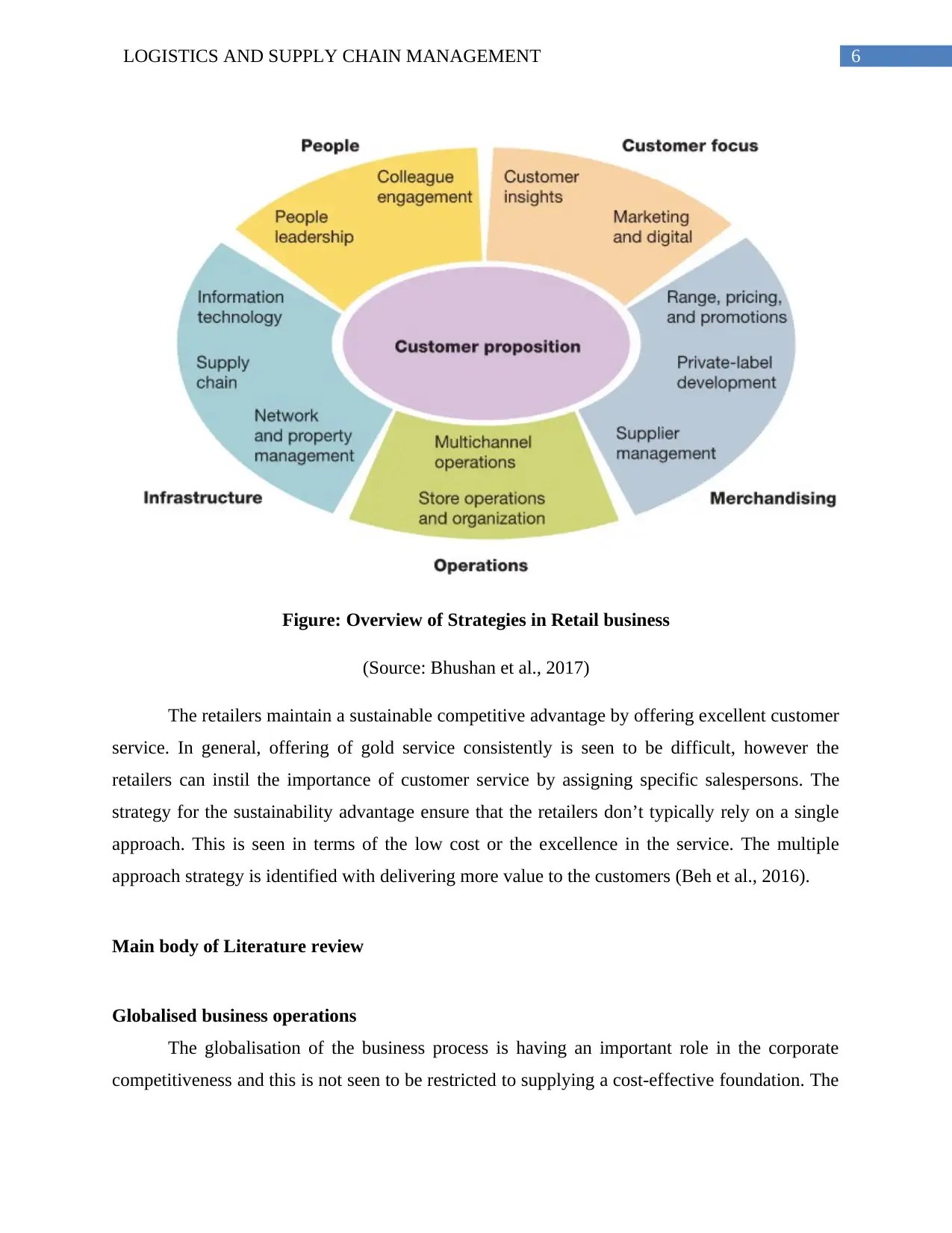
6LOGISTICS AND SUPPLY CHAIN MANAGEMENT
Figure: Overview of Strategies in Retail business
(Source: Bhushan et al., 2017)
The retailers maintain a sustainable competitive advantage by offering excellent customer
service. In general, offering of gold service consistently is seen to be difficult, however the
retailers can instil the importance of customer service by assigning specific salespersons. The
strategy for the sustainability advantage ensure that the retailers don’t typically rely on a single
approach. This is seen in terms of the low cost or the excellence in the service. The multiple
approach strategy is identified with delivering more value to the customers (Beh et al., 2016).
Main body of Literature review
Globalised business operations
The globalisation of the business process is having an important role in the corporate
competitiveness and this is not seen to be restricted to supplying a cost-effective foundation. The
Figure: Overview of Strategies in Retail business
(Source: Bhushan et al., 2017)
The retailers maintain a sustainable competitive advantage by offering excellent customer
service. In general, offering of gold service consistently is seen to be difficult, however the
retailers can instil the importance of customer service by assigning specific salespersons. The
strategy for the sustainability advantage ensure that the retailers don’t typically rely on a single
approach. This is seen in terms of the low cost or the excellence in the service. The multiple
approach strategy is identified with delivering more value to the customers (Beh et al., 2016).
Main body of Literature review
Globalised business operations
The globalisation of the business process is having an important role in the corporate
competitiveness and this is not seen to be restricted to supplying a cost-effective foundation. The
Paraphrase This Document
Need a fresh take? Get an instant paraphrase of this document with our AI Paraphraser
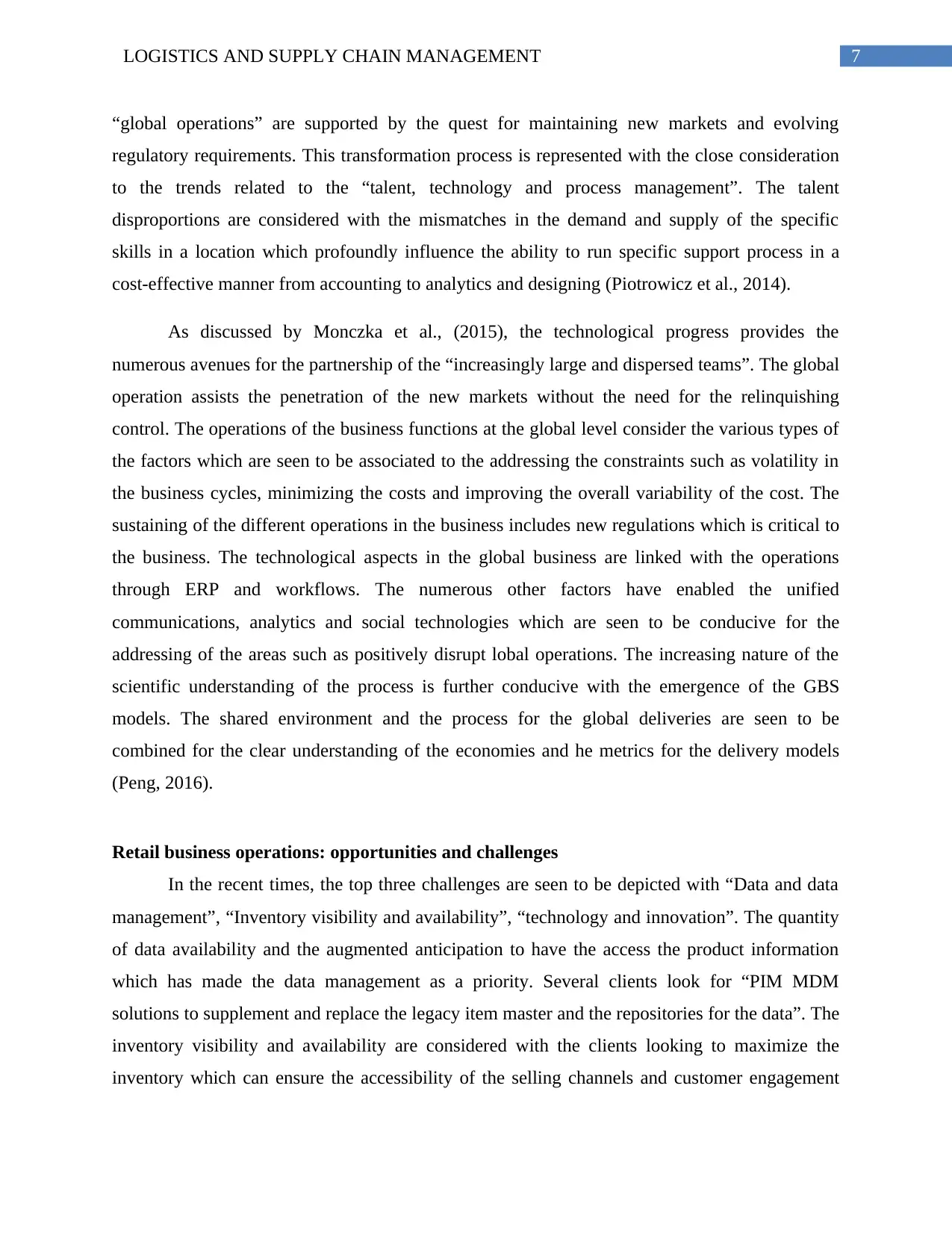
7LOGISTICS AND SUPPLY CHAIN MANAGEMENT
“global operations” are supported by the quest for maintaining new markets and evolving
regulatory requirements. This transformation process is represented with the close consideration
to the trends related to the “talent, technology and process management”. The talent
disproportions are considered with the mismatches in the demand and supply of the specific
skills in a location which profoundly influence the ability to run specific support process in a
cost-effective manner from accounting to analytics and designing (Piotrowicz et al., 2014).
As discussed by Monczka et al., (2015), the technological progress provides the
numerous avenues for the partnership of the “increasingly large and dispersed teams”. The global
operation assists the penetration of the new markets without the need for the relinquishing
control. The operations of the business functions at the global level consider the various types of
the factors which are seen to be associated to the addressing the constraints such as volatility in
the business cycles, minimizing the costs and improving the overall variability of the cost. The
sustaining of the different operations in the business includes new regulations which is critical to
the business. The technological aspects in the global business are linked with the operations
through ERP and workflows. The numerous other factors have enabled the unified
communications, analytics and social technologies which are seen to be conducive for the
addressing of the areas such as positively disrupt lobal operations. The increasing nature of the
scientific understanding of the process is further conducive with the emergence of the GBS
models. The shared environment and the process for the global deliveries are seen to be
combined for the clear understanding of the economies and he metrics for the delivery models
(Peng, 2016).
Retail business operations: opportunities and challenges
In the recent times, the top three challenges are seen to be depicted with “Data and data
management”, “Inventory visibility and availability”, “technology and innovation”. The quantity
of data availability and the augmented anticipation to have the access the product information
which has made the data management as a priority. Several clients look for “PIM MDM
solutions to supplement and replace the legacy item master and the repositories for the data”. The
inventory visibility and availability are considered with the clients looking to maximize the
inventory which can ensure the accessibility of the selling channels and customer engagement
“global operations” are supported by the quest for maintaining new markets and evolving
regulatory requirements. This transformation process is represented with the close consideration
to the trends related to the “talent, technology and process management”. The talent
disproportions are considered with the mismatches in the demand and supply of the specific
skills in a location which profoundly influence the ability to run specific support process in a
cost-effective manner from accounting to analytics and designing (Piotrowicz et al., 2014).
As discussed by Monczka et al., (2015), the technological progress provides the
numerous avenues for the partnership of the “increasingly large and dispersed teams”. The global
operation assists the penetration of the new markets without the need for the relinquishing
control. The operations of the business functions at the global level consider the various types of
the factors which are seen to be associated to the addressing the constraints such as volatility in
the business cycles, minimizing the costs and improving the overall variability of the cost. The
sustaining of the different operations in the business includes new regulations which is critical to
the business. The technological aspects in the global business are linked with the operations
through ERP and workflows. The numerous other factors have enabled the unified
communications, analytics and social technologies which are seen to be conducive for the
addressing of the areas such as positively disrupt lobal operations. The increasing nature of the
scientific understanding of the process is further conducive with the emergence of the GBS
models. The shared environment and the process for the global deliveries are seen to be
combined for the clear understanding of the economies and he metrics for the delivery models
(Peng, 2016).
Retail business operations: opportunities and challenges
In the recent times, the top three challenges are seen to be depicted with “Data and data
management”, “Inventory visibility and availability”, “technology and innovation”. The quantity
of data availability and the augmented anticipation to have the access the product information
which has made the data management as a priority. Several clients look for “PIM MDM
solutions to supplement and replace the legacy item master and the repositories for the data”. The
inventory visibility and availability are considered with the clients looking to maximize the
inventory which can ensure the accessibility of the selling channels and customer engagement
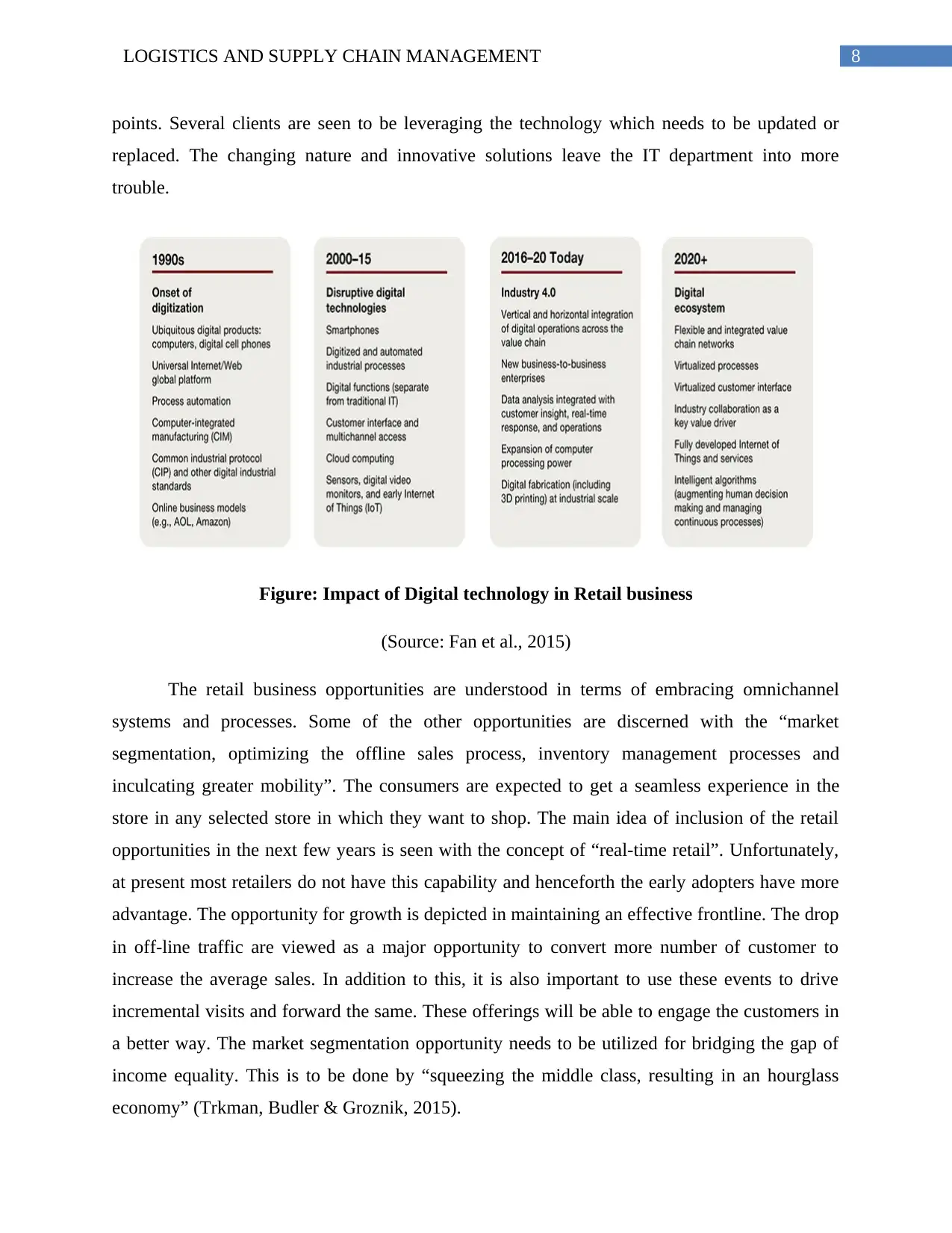
8LOGISTICS AND SUPPLY CHAIN MANAGEMENT
points. Several clients are seen to be leveraging the technology which needs to be updated or
replaced. The changing nature and innovative solutions leave the IT department into more
trouble.
Figure: Impact of Digital technology in Retail business
(Source: Fan et al., 2015)
The retail business opportunities are understood in terms of embracing omnichannel
systems and processes. Some of the other opportunities are discerned with the “market
segmentation, optimizing the offline sales process, inventory management processes and
inculcating greater mobility”. The consumers are expected to get a seamless experience in the
store in any selected store in which they want to shop. The main idea of inclusion of the retail
opportunities in the next few years is seen with the concept of “real-time retail”. Unfortunately,
at present most retailers do not have this capability and henceforth the early adopters have more
advantage. The opportunity for growth is depicted in maintaining an effective frontline. The drop
in off-line traffic are viewed as a major opportunity to convert more number of customer to
increase the average sales. In addition to this, it is also important to use these events to drive
incremental visits and forward the same. These offerings will be able to engage the customers in
a better way. The market segmentation opportunity needs to be utilized for bridging the gap of
income equality. This is to be done by “squeezing the middle class, resulting in an hourglass
economy” (Trkman, Budler & Groznik, 2015).
points. Several clients are seen to be leveraging the technology which needs to be updated or
replaced. The changing nature and innovative solutions leave the IT department into more
trouble.
Figure: Impact of Digital technology in Retail business
(Source: Fan et al., 2015)
The retail business opportunities are understood in terms of embracing omnichannel
systems and processes. Some of the other opportunities are discerned with the “market
segmentation, optimizing the offline sales process, inventory management processes and
inculcating greater mobility”. The consumers are expected to get a seamless experience in the
store in any selected store in which they want to shop. The main idea of inclusion of the retail
opportunities in the next few years is seen with the concept of “real-time retail”. Unfortunately,
at present most retailers do not have this capability and henceforth the early adopters have more
advantage. The opportunity for growth is depicted in maintaining an effective frontline. The drop
in off-line traffic are viewed as a major opportunity to convert more number of customer to
increase the average sales. In addition to this, it is also important to use these events to drive
incremental visits and forward the same. These offerings will be able to engage the customers in
a better way. The market segmentation opportunity needs to be utilized for bridging the gap of
income equality. This is to be done by “squeezing the middle class, resulting in an hourglass
economy” (Trkman, Budler & Groznik, 2015).
⊘ This is a preview!⊘
Do you want full access?
Subscribe today to unlock all pages.

Trusted by 1+ million students worldwide
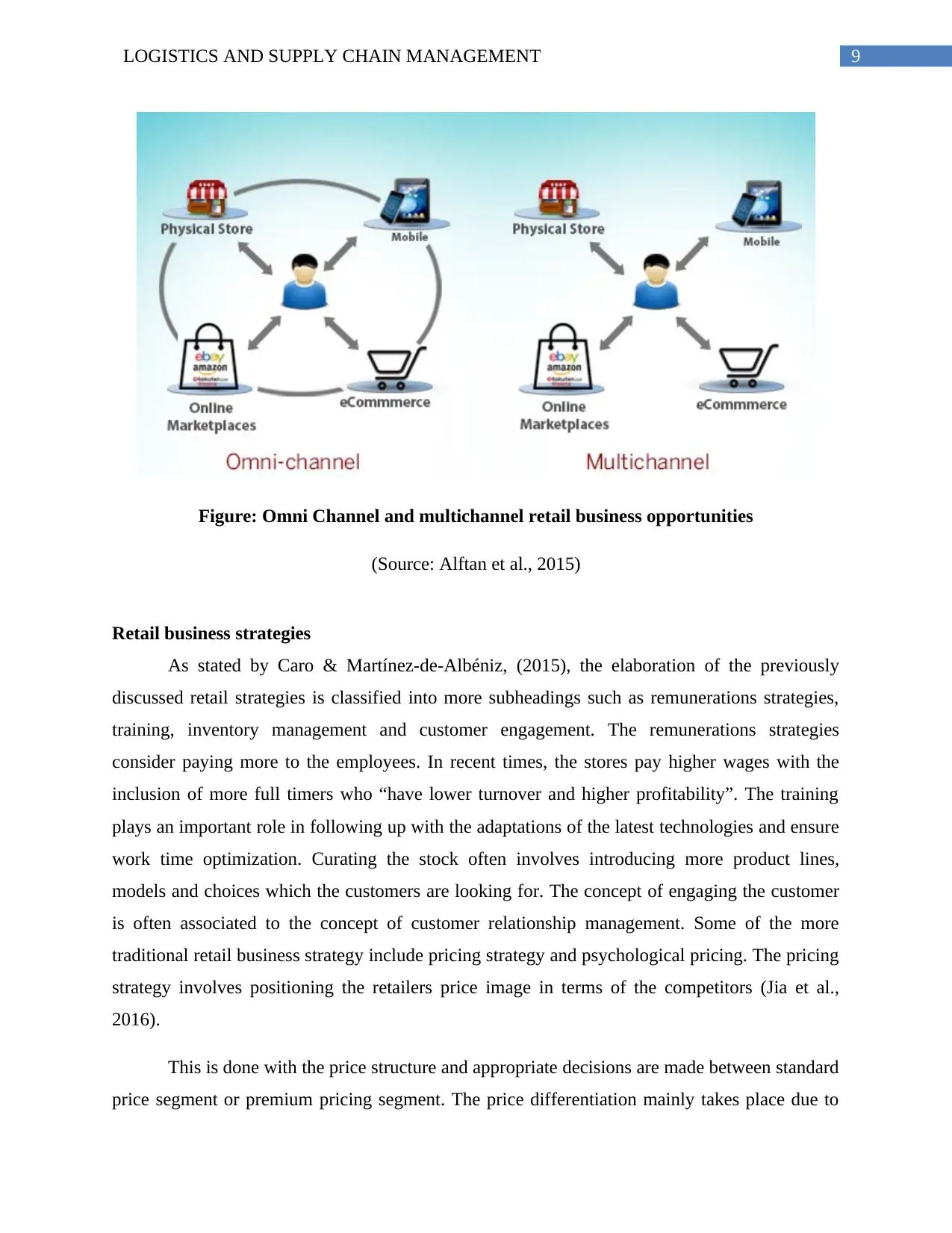
9LOGISTICS AND SUPPLY CHAIN MANAGEMENT
Figure: Omni Channel and multichannel retail business opportunities
(Source: Alftan et al., 2015)
Retail business strategies
As stated by Caro & Martínez-de-Albéniz, (2015), the elaboration of the previously
discussed retail strategies is classified into more subheadings such as remunerations strategies,
training, inventory management and customer engagement. The remunerations strategies
consider paying more to the employees. In recent times, the stores pay higher wages with the
inclusion of more full timers who “have lower turnover and higher profitability”. The training
plays an important role in following up with the adaptations of the latest technologies and ensure
work time optimization. Curating the stock often involves introducing more product lines,
models and choices which the customers are looking for. The concept of engaging the customer
is often associated to the concept of customer relationship management. Some of the more
traditional retail business strategy include pricing strategy and psychological pricing. The pricing
strategy involves positioning the retailers price image in terms of the competitors (Jia et al.,
2016).
This is done with the price structure and appropriate decisions are made between standard
price segment or premium pricing segment. The price differentiation mainly takes place due to
Figure: Omni Channel and multichannel retail business opportunities
(Source: Alftan et al., 2015)
Retail business strategies
As stated by Caro & Martínez-de-Albéniz, (2015), the elaboration of the previously
discussed retail strategies is classified into more subheadings such as remunerations strategies,
training, inventory management and customer engagement. The remunerations strategies
consider paying more to the employees. In recent times, the stores pay higher wages with the
inclusion of more full timers who “have lower turnover and higher profitability”. The training
plays an important role in following up with the adaptations of the latest technologies and ensure
work time optimization. Curating the stock often involves introducing more product lines,
models and choices which the customers are looking for. The concept of engaging the customer
is often associated to the concept of customer relationship management. Some of the more
traditional retail business strategy include pricing strategy and psychological pricing. The pricing
strategy involves positioning the retailers price image in terms of the competitors (Jia et al.,
2016).
This is done with the price structure and appropriate decisions are made between standard
price segment or premium pricing segment. The price differentiation mainly takes place due to
Paraphrase This Document
Need a fresh take? Get an instant paraphrase of this document with our AI Paraphraser
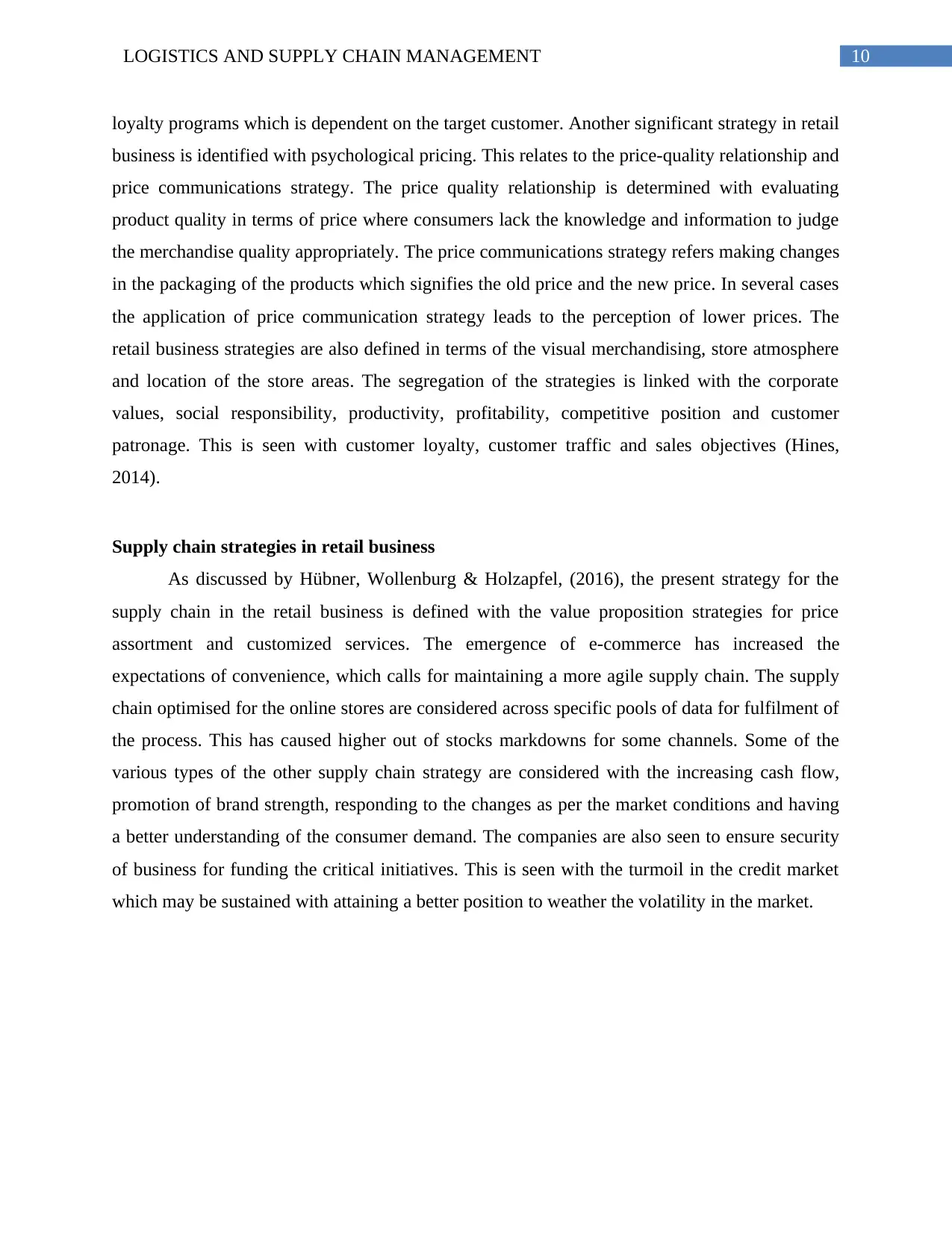
10LOGISTICS AND SUPPLY CHAIN MANAGEMENT
loyalty programs which is dependent on the target customer. Another significant strategy in retail
business is identified with psychological pricing. This relates to the price-quality relationship and
price communications strategy. The price quality relationship is determined with evaluating
product quality in terms of price where consumers lack the knowledge and information to judge
the merchandise quality appropriately. The price communications strategy refers making changes
in the packaging of the products which signifies the old price and the new price. In several cases
the application of price communication strategy leads to the perception of lower prices. The
retail business strategies are also defined in terms of the visual merchandising, store atmosphere
and location of the store areas. The segregation of the strategies is linked with the corporate
values, social responsibility, productivity, profitability, competitive position and customer
patronage. This is seen with customer loyalty, customer traffic and sales objectives (Hines,
2014).
Supply chain strategies in retail business
As discussed by Hübner, Wollenburg & Holzapfel, (2016), the present strategy for the
supply chain in the retail business is defined with the value proposition strategies for price
assortment and customized services. The emergence of e-commerce has increased the
expectations of convenience, which calls for maintaining a more agile supply chain. The supply
chain optimised for the online stores are considered across specific pools of data for fulfilment of
the process. This has caused higher out of stocks markdowns for some channels. Some of the
various types of the other supply chain strategy are considered with the increasing cash flow,
promotion of brand strength, responding to the changes as per the market conditions and having
a better understanding of the consumer demand. The companies are also seen to ensure security
of business for funding the critical initiatives. This is seen with the turmoil in the credit market
which may be sustained with attaining a better position to weather the volatility in the market.
loyalty programs which is dependent on the target customer. Another significant strategy in retail
business is identified with psychological pricing. This relates to the price-quality relationship and
price communications strategy. The price quality relationship is determined with evaluating
product quality in terms of price where consumers lack the knowledge and information to judge
the merchandise quality appropriately. The price communications strategy refers making changes
in the packaging of the products which signifies the old price and the new price. In several cases
the application of price communication strategy leads to the perception of lower prices. The
retail business strategies are also defined in terms of the visual merchandising, store atmosphere
and location of the store areas. The segregation of the strategies is linked with the corporate
values, social responsibility, productivity, profitability, competitive position and customer
patronage. This is seen with customer loyalty, customer traffic and sales objectives (Hines,
2014).
Supply chain strategies in retail business
As discussed by Hübner, Wollenburg & Holzapfel, (2016), the present strategy for the
supply chain in the retail business is defined with the value proposition strategies for price
assortment and customized services. The emergence of e-commerce has increased the
expectations of convenience, which calls for maintaining a more agile supply chain. The supply
chain optimised for the online stores are considered across specific pools of data for fulfilment of
the process. This has caused higher out of stocks markdowns for some channels. Some of the
various types of the other supply chain strategy are considered with the increasing cash flow,
promotion of brand strength, responding to the changes as per the market conditions and having
a better understanding of the consumer demand. The companies are also seen to ensure security
of business for funding the critical initiatives. This is seen with the turmoil in the credit market
which may be sustained with attaining a better position to weather the volatility in the market.
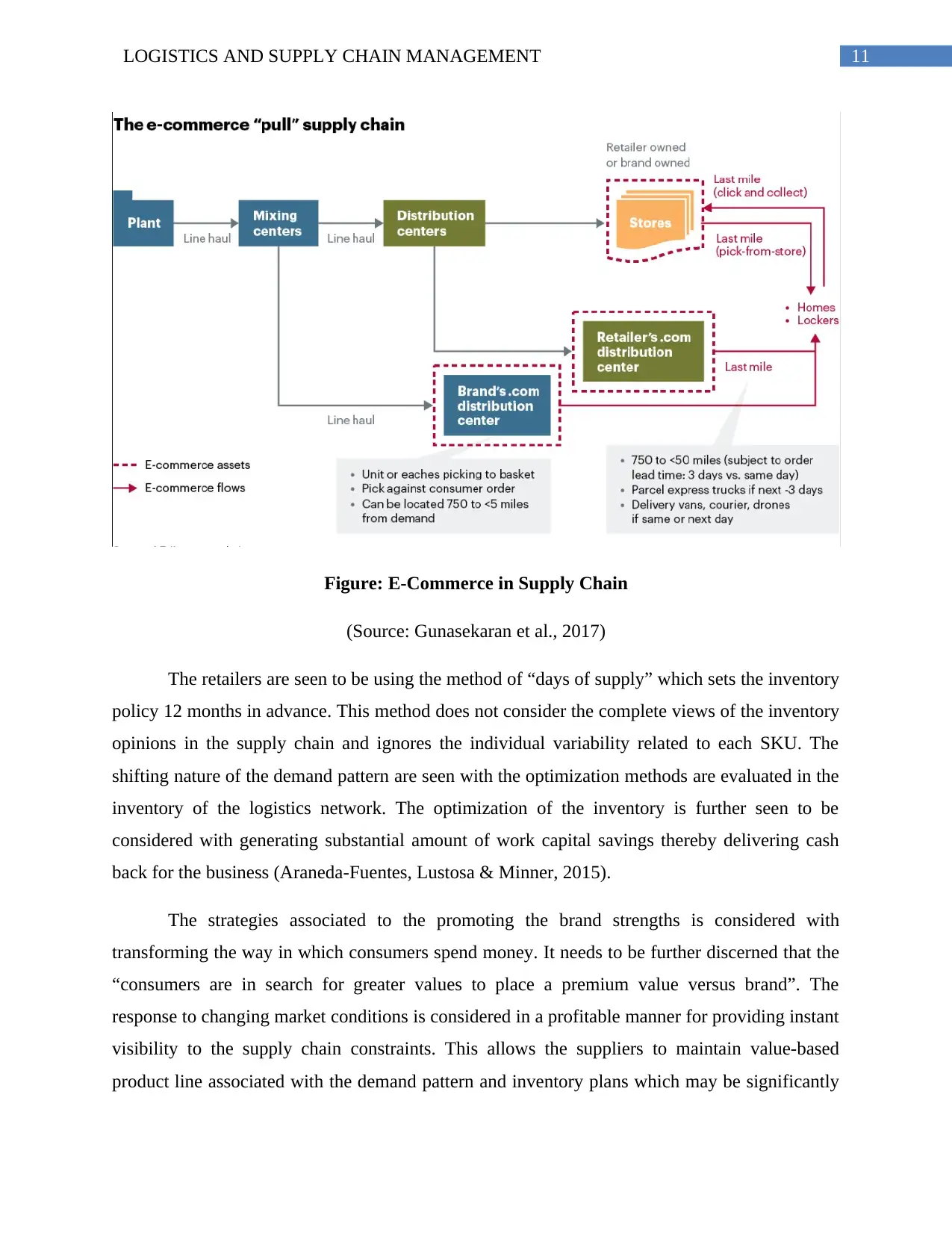
11LOGISTICS AND SUPPLY CHAIN MANAGEMENT
Figure: E-Commerce in Supply Chain
(Source: Gunasekaran et al., 2017)
The retailers are seen to be using the method of “days of supply” which sets the inventory
policy 12 months in advance. This method does not consider the complete views of the inventory
opinions in the supply chain and ignores the individual variability related to each SKU. The
shifting nature of the demand pattern are seen with the optimization methods are evaluated in the
inventory of the logistics network. The optimization of the inventory is further seen to be
considered with generating substantial amount of work capital savings thereby delivering cash
back for the business (Araneda-Fuentes, Lustosa & Minner, 2015).
The strategies associated to the promoting the brand strengths is considered with
transforming the way in which consumers spend money. It needs to be further discerned that the
“consumers are in search for greater values to place a premium value versus brand”. The
response to changing market conditions is considered in a profitable manner for providing instant
visibility to the supply chain constraints. This allows the suppliers to maintain value-based
product line associated with the demand pattern and inventory plans which may be significantly
Figure: E-Commerce in Supply Chain
(Source: Gunasekaran et al., 2017)
The retailers are seen to be using the method of “days of supply” which sets the inventory
policy 12 months in advance. This method does not consider the complete views of the inventory
opinions in the supply chain and ignores the individual variability related to each SKU. The
shifting nature of the demand pattern are seen with the optimization methods are evaluated in the
inventory of the logistics network. The optimization of the inventory is further seen to be
considered with generating substantial amount of work capital savings thereby delivering cash
back for the business (Araneda-Fuentes, Lustosa & Minner, 2015).
The strategies associated to the promoting the brand strengths is considered with
transforming the way in which consumers spend money. It needs to be further discerned that the
“consumers are in search for greater values to place a premium value versus brand”. The
response to changing market conditions is considered in a profitable manner for providing instant
visibility to the supply chain constraints. This allows the suppliers to maintain value-based
product line associated with the demand pattern and inventory plans which may be significantly
⊘ This is a preview!⊘
Do you want full access?
Subscribe today to unlock all pages.

Trusted by 1+ million students worldwide
1 out of 37
Related Documents
Your All-in-One AI-Powered Toolkit for Academic Success.
+13062052269
info@desklib.com
Available 24*7 on WhatsApp / Email
![[object Object]](/_next/static/media/star-bottom.7253800d.svg)
Unlock your academic potential
Copyright © 2020–2025 A2Z Services. All Rights Reserved. Developed and managed by ZUCOL.




